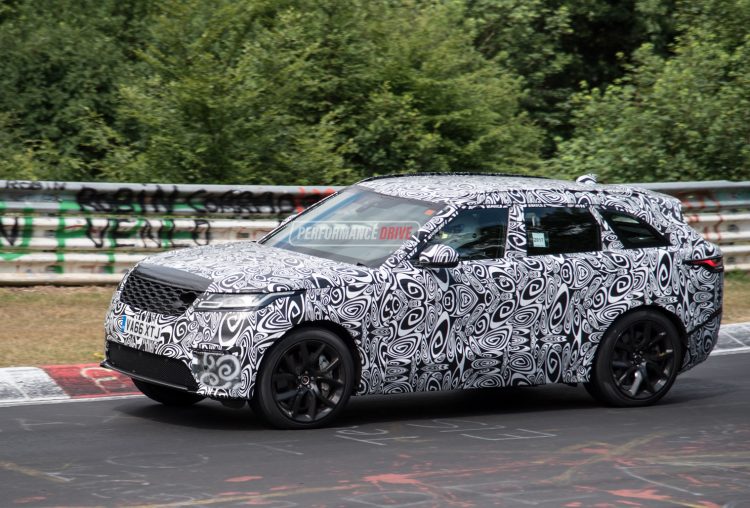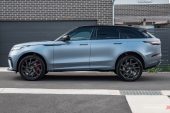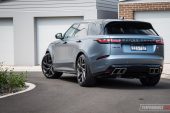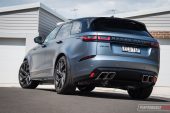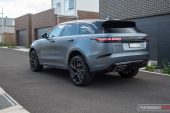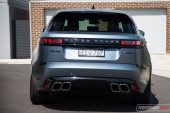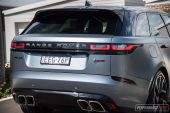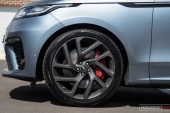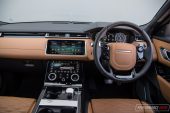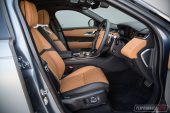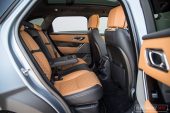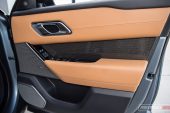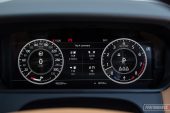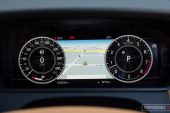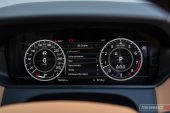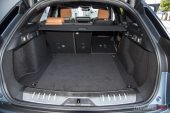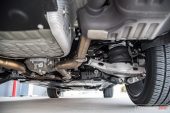Called the 2020 Range Rover Velar SVAutobiography Dynamic, you just know it’s going to be epic. Even the model name is grand. And it ought to be as this is one grand machine. It is the only V8-powered Velar on the market, and it is the equal most powerful SUV in the premium mid-size SUV class.
The Velar SVAutobiogr… let’s just call it the SVA, is the work of Jaguar Land Rover’s Special Vehicle Operations division. This is the team that builds special one-off concepts and creates unique options and accessories for various JLR products. They also produce a small fleet of production models within the regular showroom, including the F-Type SVR, the Range Rover Sport SVR, and, more recently, the Jaguar F-Pace SVR.
This actually shares a lot with the latter, including the aluminium-intensive platform and the 405kW/680Nm 5.0-litre supercharged V8. That makes it the most powerful SUV in the field, overshadowing the 375kW Alfa Romeo Stelvio QV, the 375kW BMW X3 M Competition, and the 375kW Mercedes-AMG GLC 63 S.
What’s the difference between this and the F-Pace then, you might ask? This isn’t an SVR model but instead falls into the more luxurious and pampering ‘Autobiography’ family. In short, it’s a more refined and prestige machine that offers incredible performance, while the F-Pace SVR is more about sheer performance and speed.
All of this does come at a price, though. A big price. You might want to sit down for this. It starts from an eye-watering $176,412. That excludes on-road costs and excludes any options. In fact, it doesn’t take much at all to see the figure soaring past $200,000, which means you might be more tempted to acquire a fairly high-ranking Range Rover Sport for similar money.
2020 Range Rover Velar SVAutobiography Dynamic – THE SPECS
[column width=”47%” padding=”6%”]Engine: 5.0-litre supercharged V8
Output: 405kW@6000-6500rpm / 680Nm@2500-5500rpm
Transmission: Eight-speed auto
Drive type: All-wheel drive
Wheels: F & R: 21×9.0, 265/45 (optional 22in as tested)
ANCAP: Five stars
Tare weight: 2030kg
Power-to-weight: 5.01:1 (kg:kW)
Official fuel economy: 11.7L/100km
Economy during test: 13L/100km[/column] [column width=”47%” padding=”0″]Fuel capacity/Type: 82L/95 RON
Power efficiency: 34.61kW:L/100km
0-60km/h: 2.28 seconds*
0-100km/h: 4.63 seconds*
0-200km/h: 15.74 seconds*
1/4 mile: 12.78 seconds at 182.4km/h*
Max acceleration: 1.126g
100-0km/h braking: 3.26 seconds at 40.47 metres*
Max deceleration: -1.102g
Decibel at idle (bi-modal): 50/53*
Peak decibel at 60-100km/h: 87/90*
Priced from: $176,412[/column][end_columns]
* Figures as tested by PerformanceDrive on the day. Factory claims may be different
2020 Range Rover Velar SVAutobiography Dynamic – THE PACKAGE
We won’t go into too much detail about the options and standard features as that would take all day. Instead, we’ll try to focus on the key points, and, more importantly, dive deeper into the stuff that the SVO department has done to enhance the Velar. A foundation that we categorise as one of the most opulent and genuinely luxurious propositions in the segment.
Being the flagship model the SVA extends on the beautifully polished and perfected Velar cabin. This example features an interesting dark tan and black leather upholstery. We think it contrasts perfectly with the stunning Satin Byron Blue exterior option applied here (apparently a $13,000 option). Light interiors tend to automatically feel more sumptuous and posh than dark themes. Blending in a touch of SVO flavour is the optional carbon fibre trim package ($3020). We have no complaints about this mainly because the carbon is discreetly positioned in the background of certain areas, rather than standing out like a flamboyant showoff.
Just check out that dash fascia. The way the lower touch-screen is seamlessly and elegantly integrated into the main fixture is a lesson in pleasingly aesthetic technology. Sitting, almost floating above the lower end of the screen are a pair of rotary dials that appear to be ingrained with tiny crystals. Within these donut-shaped dials are alterable displays, showing information dependant on what function you’re presently interested in; under the climate tab the screens show the desired temperature, within the vehicle settings tab the dials become toggles to flip through the multitude of driving modes available. All of these systems are supported by awesome animated graphics on the main area of the screen.
Overall the Velar is a very, very nice place to be. All surfaces and materials feel undoubtedly premium and there’s a clear sense of expensive floating in the air. It offers ample passenger space for this class too, with a perched up seating position giving you that trademark commanding view outward.
A standard sunroof provides some extra clearance for taller passengers, and in the back the rear bench has power recline adjustment so you can really kick back. And having it reclined doesn’t reduce boot space all that much, either. The Velar already offers a capacious cargo area for this class, with 673 litres opening up to 1705L with the rear seats folded down flat.
Finally getting to the exciting stuff. The SVO division has tuned and tweaked all of the areas that are imperative to performance driving. Air suspension is usually only associated with comfort and versatility, but SVO has added another dimension by squeezing in a dynamic setting for firmer cornering support and to suppress body movements. There’s also a set of 395mm front and 396mm rear disc brakes with red-painted four-piston front and single-piston rear calipers, covered by a set of bespoke 21-inch forged alloy wheels. This test vehicle has the optional 22-inch items, which look superb.
Of course, the main dish is the V8 under the bonnet. It’s the familiar Ford-based AJ-series 5.0-litre unit, pressurised by a twin-vortex supercharger. It’s not the newest engine out there, and it doesn’t offer the most advanced components and systems; no mild hybrid tech or high compression ratio. Although, it does use direct injection and variable valve timing for intake and exhaust. The compression ratio is 9.5:1, but it does have to compress upwards of 20psi of boost pressure coming from the charger.
From there the SVO department has also fettled with the ZF-based (8HP70) eight-speed automatic transmission so it offers crisper shifts, while the transfer box for the all-wheel drive system is beefed up to handle the power and torque of the V8. Peak power (405kW/550PS) is available across 6000-6500rpm, while 680Nm of torque is available from 2500-5500rpm.
Overall, Land Rover says its engineers spent 63,900 hours fine-tuning the entire calibration for the ride and handling, and the response and characteristics of the powertrain. This included countless hours of testing on the notoriously unforgiving Nurburgring – we know this first hand as we remember seeing prototypes belting around the circuit during our Nurburgring trip in 2017.
2020 Range Rover Velar SVAutobiography Dynamic – THE DRIVE
Despite all efforts to be a hardcore performance SUV, with all of that power, the Velar SVA is actually one of the slowest in this specific class. The V8 might be the most powerful but according to Range Rover 0-100km/h comes up in 4.5 seconds. Almost all of the key rivals achieve the sprint in (claimed) efforts of under 4.0 seconds, except the BMW X3 M Competition which is claimed at 4.1 (we tested 4.00). Using a private road and a Vbox Sport we clocked this test vehicle covering 0-100km/h in 4.63 seconds, with 0-200km/h coming up in 15.74 seconds.
Obviously, we aren’t talking about lazy numbers here. This rate of acceleration capability has the potential to blow your mind. It’s incredibly fast, make no mistake. Especially for an SUV. It’s just that in this somewhat contradictory world of extreme performance mixed with SUV, the Velar SVA is the slowest on the market. And it’s a similar story when you throw some corners at it.
The Velar weighs in at 2030kg (tare), making it the heaviest in this specific segment, and the adjustable air suspension is great for ride comfort – which we’ll get to soon – but it doesn’t provide the finesse or pin-sharp response of a mechanical and gas- or oil-based suspension setup in our opinion. The steering is suitably light for a Range Rover and helps the platform turn in progressively, but there is a lack of feel and responsiveness for a hardcore performance model.
All of this seems like very negative commentary. But, it is reality. However, the idea of a hardcore performance SUV is an oxymoron, really. If you want to go fast and take on corners with proper enthusiasm, or, above that, hit the track on a regular basis, you shouldn’t be looking in SUV territory to begin with. Realistically, all performance SUVs are a compromise. They invariably present surprisingly capable handling but never as good as a sports car, and at the cost of very firm suspension. Ultra-low-profile tyres usually reduce or completely eliminate any sort of meaningful off-road capability as well.
We think the Velar SVA is actually the best compromise of all the contenders. It is extremely quick in a straight line, although not quite as rapid as its rivals, yet many of the other qualities and main attractions that draw most consumers to an SUV in the first place are retained. Let’s go through some of them.
To begin with the air suspension is just lovely. It soaks up bumps and imperfections with significantly more grace and refinement than any competitor. Ride comfort is going to be important to most SUV buyers. And one of the benefits of having a raised body is that the suspension has plenty of room to compress and absorb bumps. This is what you get with the Velar SVA. You should be drawn to it precisely because it is not as hard-edged as the rivals. Not deterred because it’s not quite as agile.
Out on the road and in regular conditions, which is where most buyers are going to be spending most of their time, this SUV is wonderfully comfortable and pleasant to drive, and full of character. And not just thanks to that thunderous V8. The Velar carries a certain pomp and majesty about it that no other can. It’s also a pleasure to drive slowly. It burbles and murmurs around like it owns wherever it goes.
Another big attraction to an SUV is the fact that it’s supposed to be able to go off road. Well, aside from the questionable support from the 265/45 performance tyres, the Velar SVA is prepared to at least consider tackling various terrains. There’s a bunch of driving modes, such as sand and mud and snow, but there’s also a locking rear differential and variable torque split for the front and rear axle. To top it all off, the air suspension offers adjustment for the ride height. At its highest setting the Velar presents 251mm of ground clearance. No other SUV in this class can beat that.
2020 Range Rover Velar SVAutobiography Dynamic – THE VIDEOS
2020 Range Rover Velar SVAutobiography Dynamic – THE VERDICT
We love this so much that it’s become our new favourite mid-size SUV. Yes, it’s not as quick as the rivals and it’s not as athletic in the corners. But we think the idea of a super-fast SUV, one that handles like a sports car, is quite pointless. If you want that, just buy a sports car. The Velar SVA goes further than just offering spectacular performance though.
An SUV should appeal to you because of the practicality, cargo space, versatility, and all-terrain capability they are supposed to offer. The Velar SVA maintains pretty much all of these attributes with very little compromise, which can’t be said of the key rivals. And in terms of luxury, the Velar is, in our opinion, the most luxurious SUV in this class, in the true meaning of the word. In V8 form it’s a dainty yet beastly machine. The only real issue for most buyers will be its insane price tag, and deciding whether or not to jump up to a decent-spec Range Rover Sport for the same money.
[column width=”47%” padding=”6%”]PROS:
– Magnificent V8, most powerful in the class
– Exquisite interior with elegant integration of technology
– Most comfortable ride of all the hardcore performance mid-size SUVs
– This colour combination looks mint
– Standard massage seats, adjustable air suspension, 17-speaker stereo
[/column] [column width=”47%” padding=”0″]CONS:
– Huge price is mid-level Range Rover Sport territory
– Some expensive options that shouldn’t be options; surround-view parking camera ($1650), head-up display ($2420)
– Nice ride means it’s not as sharp as hardcore rivals, feels (and is) heavy[/column][end_columns]
As always, if you’re thinking about buying a new car don’t forget to click here to speak with our car buying specialists.





